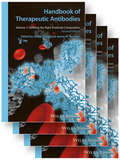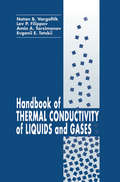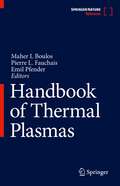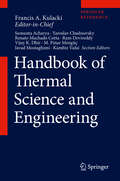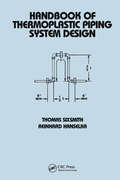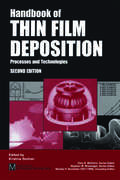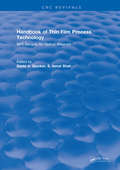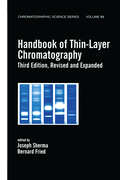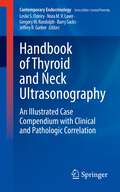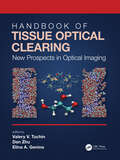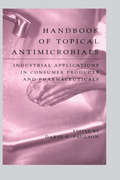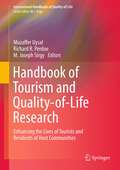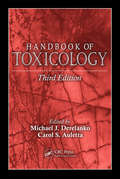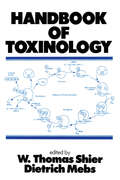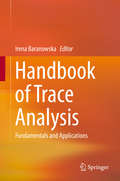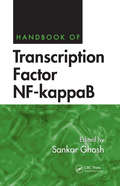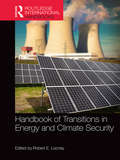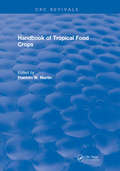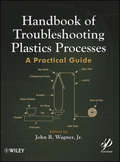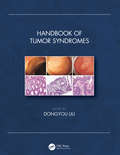- Table View
- List View
Handbook of Therapeutic Antibodies
by Stefan Dübel Janice M. ReichertStill the most comprehensive reference source on the development, production and therapeutic application of antibodies, this second edition is thoroughly updated and now has 30% more content. Volume 1 covers selection and engineering strategies for new antibodies, while the second volume presents novel therapeutic concepts and antibodies in clinical study, as well as their potential. Volumes 3 and 4 feature detailed and specific information about each antibody approved for therapeutic purposes, including clinical data. This unique handbook concludes with a compendium of marketed monoclonal antibodies and an extensive index. Beyond providing current knowledge, the authors discuss emerging technologies, future developments, and intellectual property issues, such that this handbook meets the needs of academic researchers, decision makers in industry and healthcare professionals in the clinic.
Handbook of Thermal Conductivity of Liquids and Gases
by Natan B. VargaftikHandbook of Thermal Conductivity of Liquids and Gases covers practically all of the data available on the thermalconductivity of pure liquids and gases. Thermal conductivity data included in the book is based on original experimental measurements and correlations recommended or adopted as a standard by the National Standard Reference Data Service of the Russian Federation. New tabulations of thermal conductivity data on high-molecular organic fluids and the alkali metals in both liquid and gaseous states are featured as well. This book will be an important reference for all researchers working in thermodynamics.
Handbook of Thermal Plasmas
by Pierre L. Fauchais Maher I. Boulos Emil PfenderThis authoritative reference presents a comprehensive review of the evolution of plasma science and technology fundamentals over the past five decades. One of this field’s principal challenges has been its multidisciplinary nature requiring coverage of fundamental plasma physics in plasma generation, transport phenomena under high-temperature conditions, involving momentum, heat and mass transfer, and high-temperature reaction kinetics, as well as fundamentals of material science under extreme conditions. The book is structured in five distinct parts, which are presented in a reader-friendly format allowing for detailed coverage of the science base and engineering aspects of the technology including plasma generation, mathematical modeling, diagnostics, and industrial applications of thermal plasma technology. This book is an essential resource for practicing engineers, research scientists, and graduate students working in the field.
Handbook of Thermal Science and Engineering
by Francis A. Kulacki Sumanta Acharya Yaroslav Chudnovsky Renato Machado Cotta Ram Devireddy Vijay K. Dhir M. Pinar Mengüç Javad Mostaghimi Kambiz VafaiThis Handbook provides researchers, faculty, design engineers in industrial R&D, and practicing engineers in the field concise treatments of advanced and more-recently established topics in thermal science and engineering, with an important emphasis on micro- and nanosystems, not covered in earlier references on applied thermal science, heat transfer or relevant aspects of mechanical/chemical engineering. Major sections address new developments in heat transfer, transport phenomena, single- and multiphase flows with energy transfer, thermal-bioengineering, thermal radiation, combined mode heat transfer, coupled heat and mass transfer, and energy systems. Energy transport at the macro-scale and micro/nano-scales is also included. The internationally recognized team of authors adopt a consistent and systematic approach and writing style, including ample cross reference among topics, offering readers a user-friendly knowledgebase greater than the sum of its parts, perfect for frequent consultation. The Handbook of Thermal Science and Engineering is ideal for academic and professional readers in the traditional and emerging areas of mechanical engineering, chemical engineering, aerospace engineering, bioengineering, electronics fabrication, energy, and manufacturing concerned with the influence thermal phenomena.
Handbook of Thermoplastic Piping System Design (Mechanical Engineering)
by Thomas Sixsmith Reinhard HanselkaOffers coverage of design, engineering, chemical resistance, costs, standards, codes and specifications. The text provides a resistance guide that lists over 800 chemicals and nearly 400 trade names cross-referenced to formal chemical names, covering all known chemical resistance data for the most popular thermoplastic piping systems. The book cove
Handbook of Thin Film Deposition Techniques Principles, Methods, Equipment and Applications, Second Editon
by Krishna SeshanThe Handbook of Thin Film Deposition Techniques: Principles, Methods, Equipment and Applications, Second Edition explores the technology behind the spectacular growth in the silicon semiconductor industry and the continued trend in miniaturization over the last 20 years. This growth has been fueled in large part by improved thin film deposition tec
Handbook of Thin Film Process Technology: 98/1 Reactive Sputtering
by David A GlockerThe Handbook of Thin Film Process Technology is a practical handbook for the thin film scientist, engineer and technician. This handbook is regularly updated with new material, and this volume is a special issue on reactive sputtering which will be of interest to a wide range of industrial and academic researchers in addition to owners of the main Handbook. Some recent developments in the reactive sputtering field are covered, including unbalanced magnetron sputtering and pulsed reactive sputtering. The articles contain a wealth of practical information relating to applications, practice and manufacturing techniques.
Handbook of Thin Film Process Technology: 98/2 Recipes for Optical Materials
by D GlockerThe Handbook of Thin Film Process Technology is a practical handbook for the thin film scientist, engineer and technician. This handbook is regularly updated with new material, and this volume presents additional recipe-type information (i.e. important deposition system details and process parameters) for optical materials.
Handbook of Thin-Layer Chromatography
by Bernard Fried Joseph ShermaIn this third edition, more than 40 renowned authorities introduce and update chapters on the theory, fundamentals, techniques, and instrumentation of thin-layer chromatography (TLC) and high-performance thin-layer chromatography (HPTLC), highlighting the latest procedures and applications of TLC to 19 important compound classes and coverage of TLC applications by compound type. Easily adaptable to industrial scenarios , the Handbook of Thin-Layer Chromatography, Third Edition supports practical research strategies with extensive tables of data, offers numerous figures that illustrate techniques and chromatograms, and includes a glossary as well as a directory of equipment suppliers.
Handbook of Thyroid and Neck Ultrasonography: An Illustrated Case Compendium with Clinical and Pathologic Correlation (Contemporary Endocrinology)
by Gregory W. Randolph Jeffrey R. Garber Leslie S. Eldeiry Nora M. V. Laver Barry SacksIncidentally discovered thyroid nodules and palpable neck masses present a common clinical problem. Further evaluation with neck ultrasound helps to characterize these lesions and stratify the risk of malignancy. Based on ultrasound characteristics, these lesions can be better defined using pathologic and other clinical data in order to determine the best management. This practical handbook is a case compendium based on thyroid and neck ultrasonography patterns that are commonly encountered in clinical practice. A chapter will be designated for each of the major types of thyroid nodule ultrasound features, and additional chapters will be designated for other non-thyroid neck lesions. Beginning with imaging (photographic) examples of each of the ultrasound findings, clinical cases will be used to subdivide each feature and illustrate the differential diagnoses of the various types of thyroid and neck lesions. Associated cytology and histopathology images will be shown and described, as well as clinical data, including relevant history, physical exam, molecular marker results and clinical course. Chapters will include bulleted key points for quick reference as well as suggested readings for further investigation.While several handbooks exist to educate readers about neck and thyroid ultrasonography and about cytopathology, this is a unique work that combines ultrasound and pathology data into a case-based, easy-to-read and concise format that fits in your pocket, adapting common terminology that is emerging for ultrasound, which will allow readers to employ a "standardized" approach to evaluating nodules, depending on the risk scoring system used.
Handbook of Tissue Optical Clearing: New Prospects in Optical Imaging
by Valery V. Tuchin, Dan Zhu, and Elina A. GeninaBiomedical photonics is currently one of the fastest growing fields, connecting research in physics, optics, and electrical engineering coupled with medical and biological applications. It allows for the structural and functional analysis of tissues and cells with resolution and contrast unattainable by any other methods. However, the major challenges of many biophotonics techniques are associated with the need to enhance imaging resolution even further to the sub-cellular level as well as translate them for in vivo studies. The tissue optical clearing method uses immersion of tissues into optical clearing agents (OCAs) that reduces the scattering of tissue and makes tissue more transparent and this method has been successfully used ever since. This book is a self-contained introduction to tissue optical clearing, including the basic principles and in vitro biological applications, from in vitro to in vivo tissue optical clearing methods, and combination of tissue optical clearing and various optical imaging for diagnosis. The chapters cover a wide range of issues related to the field of tissue optical clearing: mechanisms of tissue optical clearing in vitro and in vivo; traditional and innovative optical clearing agents; recent achievements in optical clearing of different tissues (including pathological tissues) and blood for optical imaging diagnosis and therapy. This book provides a comprehensive account of the latest research and possibilities of utilising optical clearing as an instrument for improving the diagnostic effectiveness of modern optical diagnostic methods. The book is addressed to biophysicist researchers, graduate students and postdocs of biomedical specialties, as well as biomedical engineers and physicians interested in the development and application of optical methods in medicine. Key features: The first collective reference to collate all known knowledge on this topic Edited by experts in the field with chapter contributions from subject area specialists Brings together the two main approaches in immersion optical clearing into one cohesive book
Handbook of Topical Antimicrobials: Industrial Applications in Consumer Products and Pharmaceuticals
by Daryl S. PaulsonThis reference examines laboratory techniques and FDA and industry perspectives on medical, food service, and consumer product applications of antimicrobials. It offers methods to conduct investigations of effectiveness that simulate use of consumer, food, and medical antimicrobials in real-world conditions and environments, validate neutralizing s
Handbook of Tourism and Quality-of-Life Research: Enhancing the Lives of Tourists and Residents of Host Communities
by Muzaffer Uysal M. Joseph Sirgy Richard PerdueQuality of life (QOL) research in tourism has gained much momentum over the last two decades. Academics working in this area research issues related to tourists and host communities. Practitioners are becoming increasingly interested in understanding the science that allows them to develop better marketing and managerial programs designed to enhance the quality of life of tourists. Tourism bureaus and government agencies are increasingly interested in issues of sustainable tourism, specifically in understanding and measuring the impact of tourism on the quality of life of the residents of the host communities. This handbook covers all relevant topics and is divided into two parts: research relating to travelers/tourists, and research relating to the residents of host communities. It is the only state-of-the-art reference book in its field and will prove invaluable to academics interested in QOL research, as well as tourism practitioners interested in applying the science of QOL in the tourism industry.
Handbook of Toxicology
by Michael J. Derelanko Carol S. AulettaThe Handbook of Toxicology, Third Edition provides an updated practical reference source for practicing toxicologists in the pharmaceutical and chemical industries, contract laboratories, regulatory agencies, and academia. Written by experts in their specific toxicology fields, the chapters provide both fundamental and applied information. Topics r
Handbook of Toxinology
by W. Thomas Shier and Dietrich MebsOrganized primarily around the mechanisms of action of the toxins at the biochemical, physiological and pathological level, rather than by source, the handbook covers most toxins which have been clearly identified and characterized, but emphasizes toxins that are more important by virtue of the sign
Handbook of Trace Analysis
by Irena BaranowskaThis handbook is unique in its comprehensive coverage of the subject and focus on practical applications in diverse fields. It includes methods for sample preparation, the role of certified reference materials, calibration methods and statistical evaluation of the results. Problems concerning inorganic and bioinorganic speciation analysis, as well as special aspects such as trace analysis of noble metals, radionuclides and volatile organic compounds are also discussed. A significant part of the content presents applications of methods and procedures in medicine (metabolomics and therapeutic drug monitoring); pharmacy (the analysis of contaminants in drugs); studies of environmental samples; food samples and forensic analytics - essential examples that will also facilitate problem solving in related areas.
Handbook of Trace Evidence Analysis
by Vincent J DesiderioCovers new trace evidence techniques and expanding areas of analysis, along with key theory and applications Developed around the need for updated information in the disciplines of trace evidence the Handbook of Trace Evidence Analysis focuses on the increasing awareness and need for validation, modern methods for addressing and controlling contamination, the shift towards incorporating statistical analyses into the interpretation phase and cutting edge research into new forensic science methods and their application. Beginning with an overview of the topic and discussing the important role that information derived from trace materials can provide during investigations, the book then presents chapters on key techniques. The first being the critical nature of microscopy, and the methods employed for the recognition, collection, and preservation of trace evidence. Subsequent chapters review the core disciplines of trace evidence examination: paints and polymers, hairs, fibers and textiles and glass. Each chapter contains in-depth discussions on the origin of the materials involved, including any natural or synthetic processes involved in their production, the nuances involved in their detection, and the methods of analysis that are used to extract valuable information from samples. In addition, suggested workflows in method and testing selections, as well as addressing specific scientific challenges as well as the limitations of knowledge on the transfer, persistence and background abundance of trace materials are discussed. The book ends by examining the interpretation of trace evidence findings from a historical perspective and examining the methods that are currently being developed. Provides an in-depth introduction to the general area of trace evidence and discusses current and new techniques Consolidates trace evidence and materials categories of testing into one reference series Offers a detailed focus on technical approaches and guidelines to trace evidence Includes analytical schemes/workflows and valuable guides for the interpretation of data and results The Handbook of Trace Evidence will appeal to forensic science academics, students, and practitioners in the trace evidence and materials science disciplines, as well as DNA analysts, toxicologists, forensic anthropologists, crime laboratory managers, criminal justice students and practitioners, and legal professionals. It would also be a valuable resource for every crime laboratory reference library.
Handbook of Transcription Factor NF-kappaB
by Sankar GhoshRecent evidence proving the molecular link between unchecked, chronic inflammation and cancer has implicated the transcription factor NF-kB as a key factor in both inhibiting apoptosis and promoting cell proliferation. Since its initial identification 20 years ago as a simple regulating factor in one small part of the immune response, NF-kB is prov
Handbook of Transition Metal Polymerization Catalysts
by Ray HoffIncluding recent advances and historically important catalysts, this book overviews methods for developing and applying polymerization catalysts – dealing with polymerization catalysts that afford commercially acceptable high yields of polymer with respect to catalyst mass or productivity.• Contains the valuable data needed to reproduce syntheses or use the catalyst for new applications• Offers a guide to the design and synthesis of catalysts, and their applications in synthesis of polymers • Includes the information essential for choosing the appropriate reactions to maximize yield of polymer synthesized• Presents new chapters on vanadium catalysts, Ziegler catalysts, laboratory homopolymerization, and copolymerization
Handbook of Transitions to Energy and Climate Security (Routledge International Handbooks)
by Robert E. LooneyAn original contribution to our understanding of a phenomenon that is reshaping the world, this title thoroughly discusses the transformation of the energy security policy arena brought on by two dramatic developments – the increased potential availability of energy in many parts of the world on the supply side, and on the demand side increasing concerns over the harmful effects on the environment brought on by the use of fossil fuels. An in depth discussion specifically focuses on what energy security means to different countries, and examines which of those countries appear to be managing their energy/climate transitions successfully and which are having a more difficult time adapting to the new environment. Part 1 introduces the topic, covering the main themes and provides an overview of the chapters Part 2 provides a framework for policy evaluation, considering the evolving factors affecting energy security and the energy/climate policy trilemma Parts 3 to 6 discuss energy transitions in the carbon producing countries (Saudi Arabia, Canada, Iran, Russia, Mexico), in intermediate carbon/producing/consuming countries (China, United States, UK, Brazil, Argentina, South Africa), in carbon consuming countries (Germany, Japan, South Korea, Israel, India, Spain) and finally in carbon reduction countries (France, Denmark, Switzerland) Part 7 looks at attempts at regional/international cooperation Part 8 considers the prospects for the future, examining technological breakthroughs. This title builds on the theme of unfolding energy transformations driven by, but increasingly constrained by climate/environmental considerations. It is ideal for researchers and students in the areas of environmental politics and policy, climate change, and energy and climate security, as well as for academics and professionals.
Handbook of Transparent Conductors
by David S. Ginley Hideo Hosono David C. PaineTransparent conducting materials are key elements in a wide variety of current technologies including flat panel displays, photovoltaics, organic, low-e windows and electrochromics. The needs for new and improved materials is pressing, because the existing materials do not have the performance levels to meet the ever- increasing demand, and because some of the current materials used may not be viable in the future. In addition, the field of transparent conductors has gone through dramatic changes in the last 5-7 years with new materials being identified, new applications and new people in the field. "Handbook of Transparent Conductors" presents transparent conductors in a historical perspective, provides current applications as well as insights into the future of the devices. It is a comprehensive reference, and represents the most current resource on the subject.
Handbook of Tropical Food Crops
by Franklin W. MartinFirst Published in 2018. Routledge is an imprint of Taylor & Francis, an Informa company.
Handbook of Troubleshooting Plastics Processes
by John R. Wagner Jr.This handbook provides a framework for understanding how to characterize plastic manufacturing processes for use in troubleshooting problems. The 21 chapters are authored by well-known and experienced engineers who have specialized knowledge about the processes covered in this practical guide. From the Preface: "In every chapter, the process is described and the most common problems are discussed along with the root causes and potential technical solutions. Numerous case studies are provided that illustrate the troubleshooting process. Mark A. Spalding, The Dow Chemical Company
Handbook of Tumor Syndromes
by Dongyou LiuTumors/cancers are characterized by uncontrolled growths of abnormal cells that extend beyond their usual boundaries and disrupt the normal functions of affected organs and systems. While about 75%–80% of tumors/cancers arise sporadically without a family connection, 20%–25% appear to be familial (including 10%–15% nonhereditary familial tumors [or familial tumors] and 5%–10% hereditary familial tumors [or hereditary tumors]). As nonhereditary and hereditary familial tumors often show both tumor-related and non-tumor-related (or syndromic) symptoms, they are referred to as tumor syndromes (or cancer susceptibility syndromes). In comparison with sporadic tumors/cancers, tumor syndromes (>300 described so far) tend to occur at a younger age, involve multiple organs and systems, produce multiple (often in a distinct spectrum) and bilateral lesions, form multiple hamartomatous, benign, or precursor lesions; locate in specific site(s), display unique syndromic features, and affect multiple members/generations of a family. This book provides state-of-art and authoritative coverage of nearly 100 tumor syndromes, with chapters presenting overviews of individual tumor syndromes in relation to their biology, epidemiology, pathogenesis, clinical features, diagnosis, treatment, and prognosis. Featuring contributions from oncologists, clinicians, and specialists, the book offers a reliable, comprehensive reference on tumor syndromes for scholars and students of medicine, dentistry, pharmacology, nursing, public health, and other biomedical disciplines. Key Features Reviews the biology, epidemiology, pathogenesis, and clinical features of tumor syndromes Contains up-to-date information on the diagnosis and treatment of tumor syndromes Includes expert coverage from leading oncologists and clinicians Related Titles J. R. McIntosh, Understanding Cancer: An Introduction to the Biology, Medicine, and Societal Implications of This Disease (ISBN 978-0-8153-4535-0) P. S. T. Shanmugam, Understanding Cancer Therapies (ISBN 978-1-1381-9815-9) J. M. Baehring and J. M. Piepmeier, eds., Brain Tumors: Practical Guide to Diagnosis and Treatment (ISBN 978-0-3673-9022-8) D. Liu, Tumors and Cancers: Endocrine Glands – Blood – Marrow – Lymph (ISBN 978-1-4987-2975-8) Dongyou Liu, PhD, has worked at several research and clinical laboratories in Australia and the United States for the past three decades, with a focus on molecular characterization of microbial pathogens and detection of human genetic disorders and tumors/cancers. He is the primary author of more than 50 original research and review articles in various peer-reviewed international journals, the contributor of 197 book chapters, and the editor of more than 10 books.
